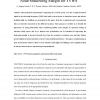Free Online Productivity Tools
i2Speak
i2Symbol
i2OCR
iTex2Img
iWeb2Print
iWeb2Shot
i2Type
iPdf2Split
iPdf2Merge
i2Bopomofo
i2Arabic
i2Style
i2Image
i2PDF
iLatex2Rtf
Sci2ools
TBC
2016
2016
Polarization and Effects on Hidden Node/Shadowing Margin for TVWS
—Dual polarized measurements comparing the received power of a line of sight broadcast signal in the ultra-high frequency (UHF) band with received power in suburban streets and indoors including high rise buildings are presented in this paper. Both the co-polarized and cross-polarized fades are therefore measured in the different locations. Their purpose is twofold: a) to identify the importance of using polarization when considering hidden node margins in spectrum sensing of television white spaces and b) to indicate how polarization can be beneficial in improving the shadowing margin to increase the path loss from the secondary to primary user and thus further protect digital terrestrial television receivers from harmful interference. The impact of polarization in open environments with low clutter or near windows inside high rise buildings is more significant than in densely cluttered spaces experiencing strong multipath.
TBC 2016 |
| Added | 10 Apr 2016 |
| Updated | 10 Apr 2016 |
| Type | Journal |
| Year | 2016 |
| Where | TBC |
| Authors | Alejandro Aragón Zavala, Tim W. C. Brown, Gerardo Castañón |
Comments (0)

